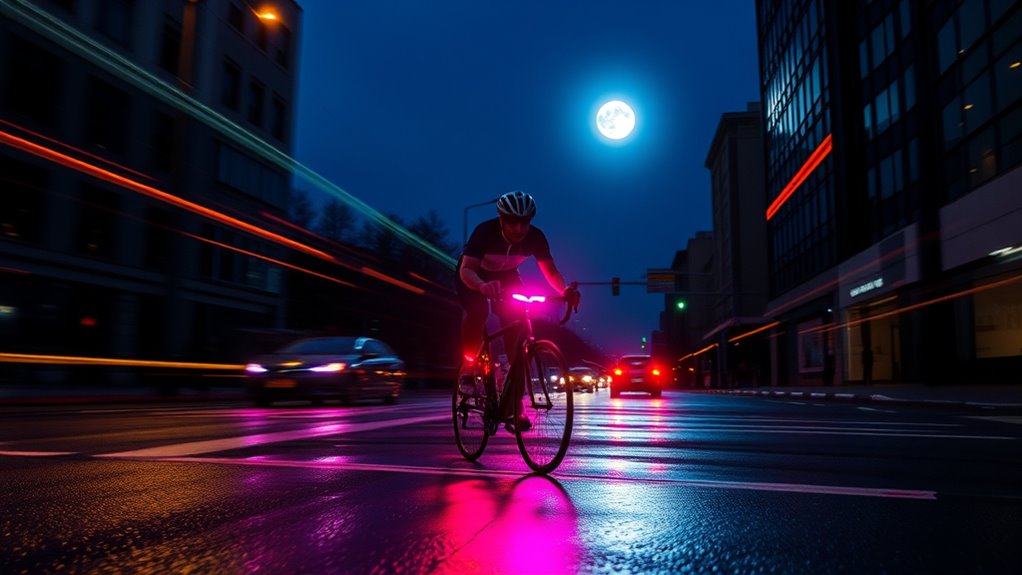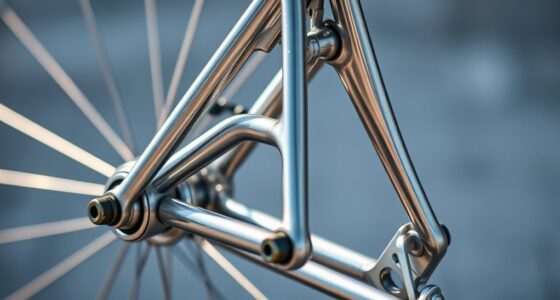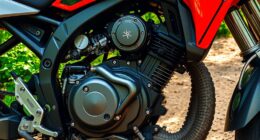To stay safe during night riding, choose headlights with adjustable brightness and wide or concentrated beams for better visibility, and supplement them with high-intensity LED lights for brightness and durability. Wear reflective gear and add auxiliary lights to increase your visibility from all angles. Always check and maintain your lighting system regularly, reduce your speed, and keep safe following distances. If you keep these tips in mind, you’ll discover even more ways to ride safely through the night.
Key Takeaways
- Use high-quality, adjustable headlights and auxiliary lights to improve visibility and alert other drivers during night riding.
- Incorporate reflective gear and tapes on clothing and bikes to enhance visibility from multiple angles.
- Reduce speed appropriately for visibility conditions and maintain safe following distances to prevent accidents.
- Regularly inspect, clean, and properly adjust lighting systems to ensure maximum brightness and effectiveness.
- Use flashing lights and signals to communicate rider intentions clearly, increasing safety and awareness on dark roads.
Choosing the Right Headlights for Night Riding
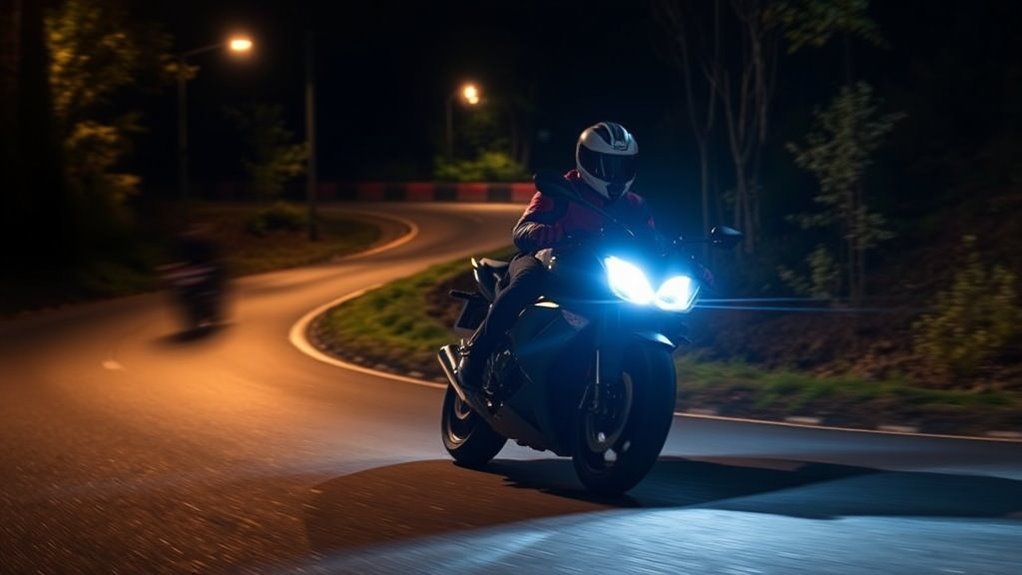
Choosing the right headlights is essential for safe night riding because proper illumination helps you see the road clearly and be seen by others. You want headlights that provide a bright, focused beam without blinding oncoming drivers. Look for lights with adjustable brightness levels so you can adapt to different conditions. Consider the beam pattern; a wide, even spread helps you see more of the road, while a concentrated beam extends your distance vision. Durability matters, too—choose waterproof and impact-resistant options to withstand rough conditions. Easy installation and battery life are important, especially for longer rides. Investing in quality headlights improves your visibility and safety, giving you confidence as you navigate dark roads. The right lighting setup is a vital first step for safe night riding. Additionally, selecting headlights with water efficiency features ensures reliable performance in various weather conditions and reduces maintenance needs.
The Benefits of High-Intensity LED Lights
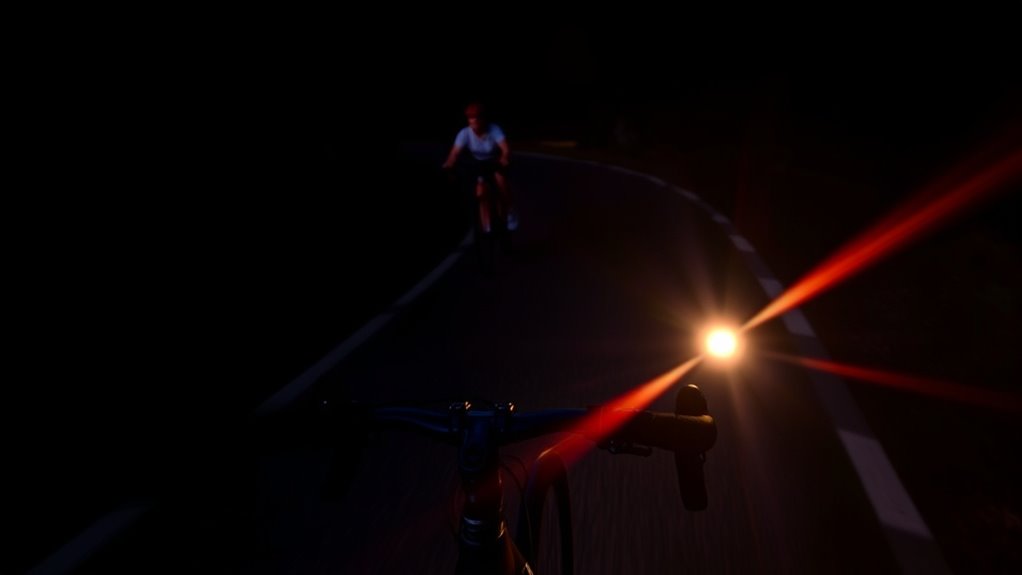
High-intensity LED lights offer significant advantages for night riding, making them a popular choice among cyclists and motorcyclists alike. They provide brighter, clearer illumination, helping you see obstacles and road signs more quickly. This increased visibility reduces the risk of accidents and enhances safety at higher speeds. LED lights also consume less power, extending your battery life without sacrificing brightness. Additionally, they are durable and resistant to shock, making them reliable in various weather conditions. Kia Tuning can include upgrading lighting systems for better visibility and safety. Here’s a quick comparison:
| Feature | Traditional Lights | High-Intensity LED Lights | Benefits |
|---|---|---|---|
| Brightness | Moderate | Very Bright | Better visibility |
| Power Consumption | Higher | Lower | Longer ride time |
| Durability | Moderate | High | Lasts longer |
| Cost | Lower | Slightly Higher | Long-term savings |
Switching to high-intensity LEDs boosts safety and performance during night rides.
Incorporating Reflective Gear for Enhanced Visibility
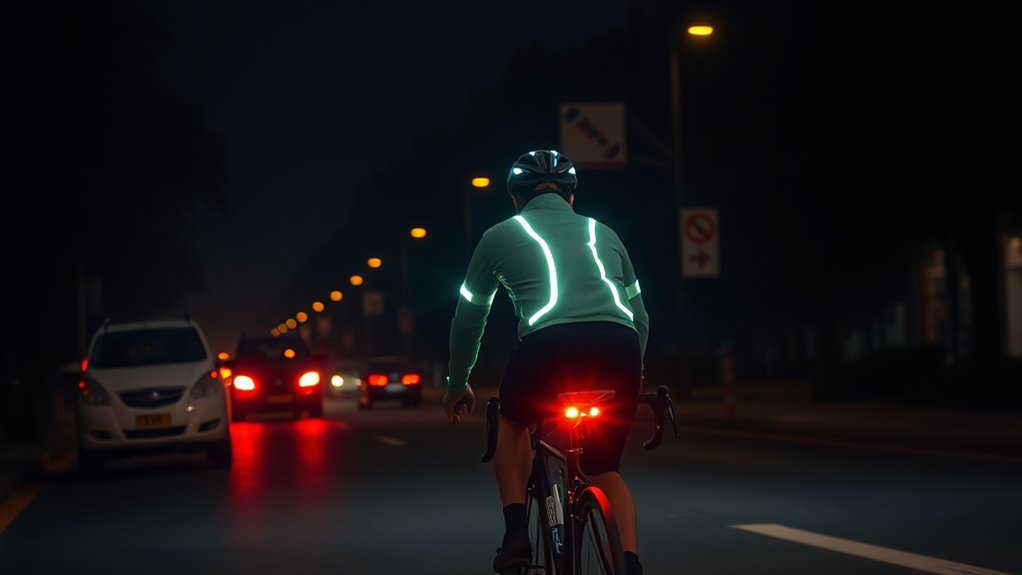
To boost your visibility during night rides, incorporating reflective gear is essential. Reflective accessories catch headlights from vehicles, making you more noticeable from afar. Wearing reflective vests, ankle straps, or helmet decals ensures that you’re seen from multiple angles. Opt for gear with high-quality, 3M Scotchlite or similar reflective materials to maximize effectiveness. Proper placement is key; ensure reflectors are positioned on the front, sides, and rear of your gear for comprehensive visibility. Consider clothing with built-in reflectivity or add reflective tapes to your existing attire. This simple step can substantially reduce the risk of accidents in low-light conditions and helps drivers anticipate your presence well in advance. Additionally, understanding city dynamics can help you choose safer routes and times for night riding.
Using Auxiliary Lights to Brighten Your Path
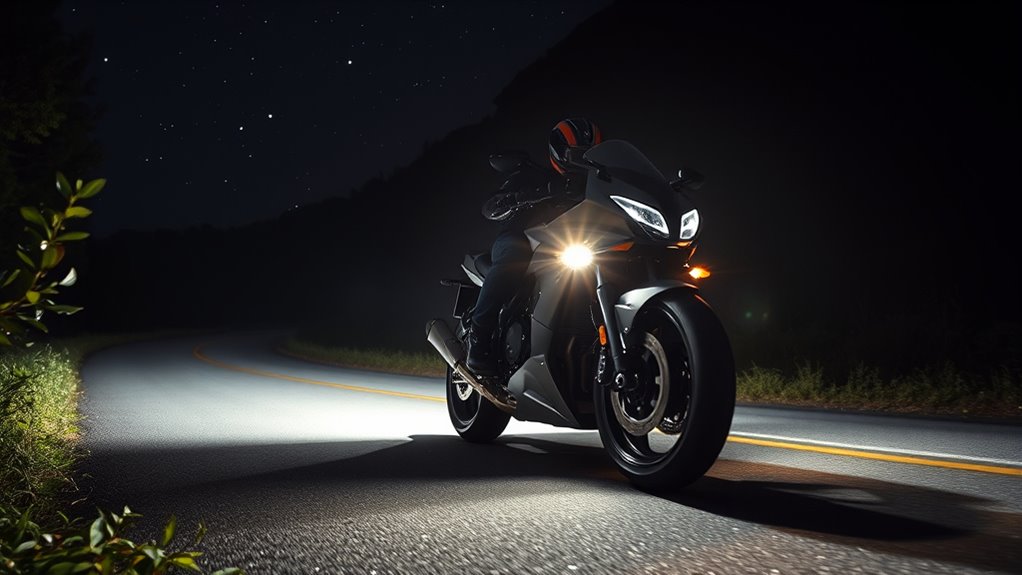
Auxiliary lights can substantially improve your visibility on dark roads, helping you spot obstacles and navigate safely at night. These additional lights supplement your main headlights, providing extra illumination in challenging conditions. By installing auxiliary lights such as fog lights or LED bars, you can better see the road edges, potholes, and debris that might otherwise go unnoticed. They also make your vehicle more visible to other drivers, reducing the risk of collisions. When choosing auxiliary lights, consider their placement and brightness to guarantee they don’t dazzle oncoming traffic. Properly aimed and maintained lights enhance your overall safety without distracting others. Using auxiliary lights effectively allows you to see farther and more clearly, giving you confidence to ride more securely through dark or poorly lit areas. Understanding how different lighting solutions impact visibility can help you select the best setup for your riding environment.
Safety Tips for Maintaining Proper Speed at Night
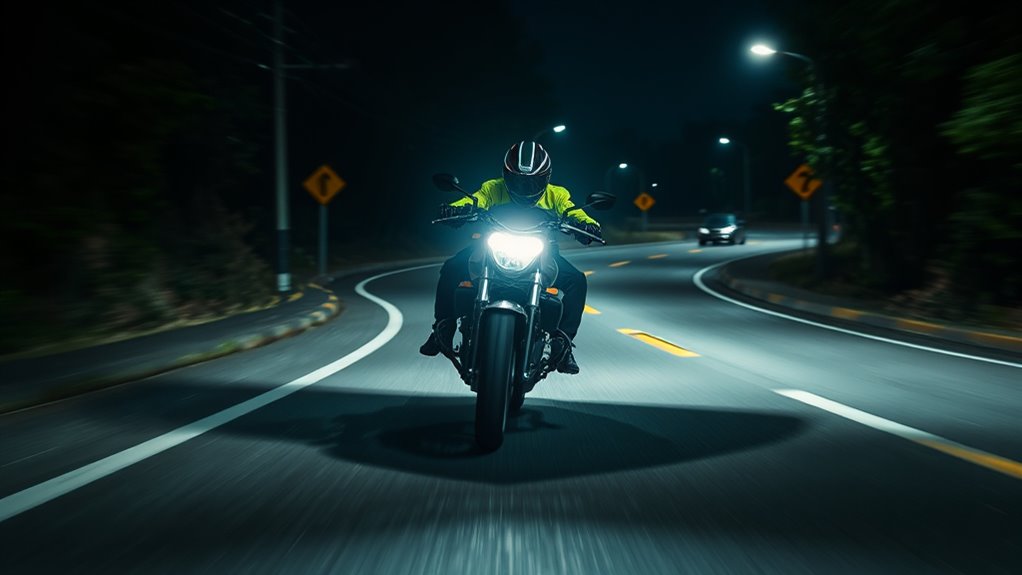
Driving at night requires you to modify your speed to match the limited visibility and road conditions. Staying within safe limits helps prevent accidents and ensures you can react promptly to unexpected hazards. Always reduce your speed when approaching curves, intersections, or areas with poor lighting. Keep a safe following distance to allow for longer stopping times. Use your headlights effectively to maximize visibility without blinding other drivers. Be mindful of your surroundings and avoid the temptation to speed just because the road appears clear. Regularly check your speedometer to stay within safe limits. Adjust your speed based on weather conditions such as rain or fog. Stay alert for pedestrians, animals, or debris that may suddenly appear. Additionally, being aware of seasonal variations and natural surroundings can help you anticipate potential hazards during nighttime driving.
How to Properly Mount and Adjust Your Lighting Equipment
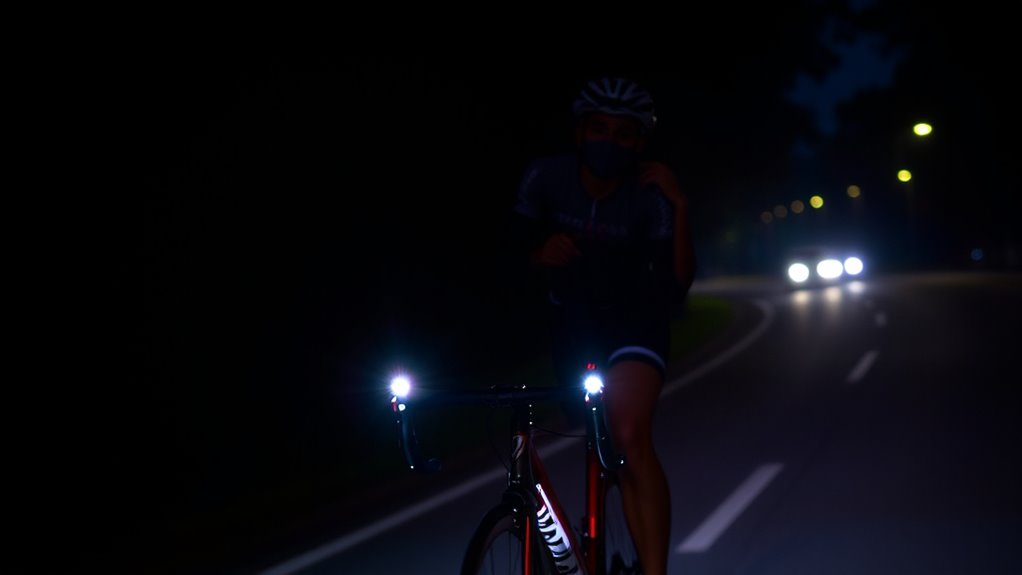
Ensuring your lighting equipment is properly mounted and adjusted is essential for safe night riding. Start by securing your front light firmly to prevent movement while riding. Make sure the beam is angled slightly downward to illuminate the road ahead without blinding others. Adjust the height so it’s visible but doesn’t cause glare. Your rear light should be securely attached to the seat post or bike frame, positioned to be clearly visible from behind. Check that all batteries are fresh or fully charged to maintain brightness. Test your lights before your ride to confirm they’re working correctly and properly aligned. Proper mounting and adjustment not only improve your visibility but also help other drivers see you clearly, reducing the risk of accidents. Incorporating data-driven strategies into your lighting setup can further optimize your visibility and safety during night rides.
The Importance of Brake and Taillight Visibility
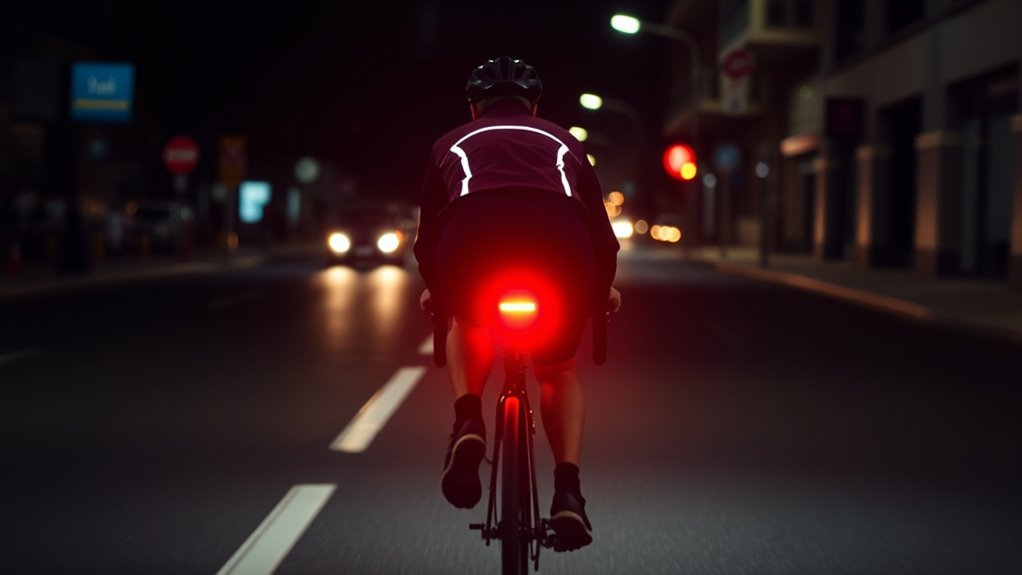
Your brake and taillights play a vital role in preventing crashes by making your movements clear to others. When these lights are highly visible, you’re easier to recognize, especially in low-light conditions. Ensuring they’re working properly can considerably boost your safety on night rides. Incorporating AI-powered sensor technology can further enhance lighting safety by automatically adjusting brightness levels based on ambient conditions.
Enhances Crash Prevention
Since brake and taillights are essential signals for alerting others to your movements, their visibility can greatly reduce the risk of accidents at night. When these lights are clearly visible, drivers and other cyclists can anticipate your actions, giving them more time to react. This proactive communication is critical for crash prevention, especially in low-light conditions. To maximize safety, consider using high-intensity, flashing taillights that attract attention. Additionally, make sure your brake lights activate promptly when you apply brakes. Properly maintained, bright lights serve as a universal language on the road, signaling your intentions clearly. Incorporating professional voiceover techniques in your safety messaging can further enhance awareness and compliance among road users. Regularly check and maintain light functionality to prevent failures.
Ensures Rider Recognition
Clear brake and taillight visibility is essential for helping others recognize who you are and what you’re doing on the road. When you brake or slow down, bright, flashing lights alert drivers behind you, preventing surprises. A well-lit taillight makes your presence obvious, especially in low-light conditions or bad weather. This visibility helps drivers maintain a safe distance and respond appropriately. Without proper lighting, others might mistake your intentions or fail to notice your stops, increasing the risk of rear-end collisions. Choose high-quality, bright lights that are visible from a distance and ensure they’re correctly positioned. Regularly check and replace worn-out bulbs to keep your signals clear. Effective brake and taillight visibility isn’t just about legal compliance — it’s about keeping yourself safe and making your movements predictable. Proper lighting solutions also enhance your overall safety, especially when combined with other lighting upgrades like ambient lighting or custom gauges.
Incorporating Flashing Lights and Signals for Safety
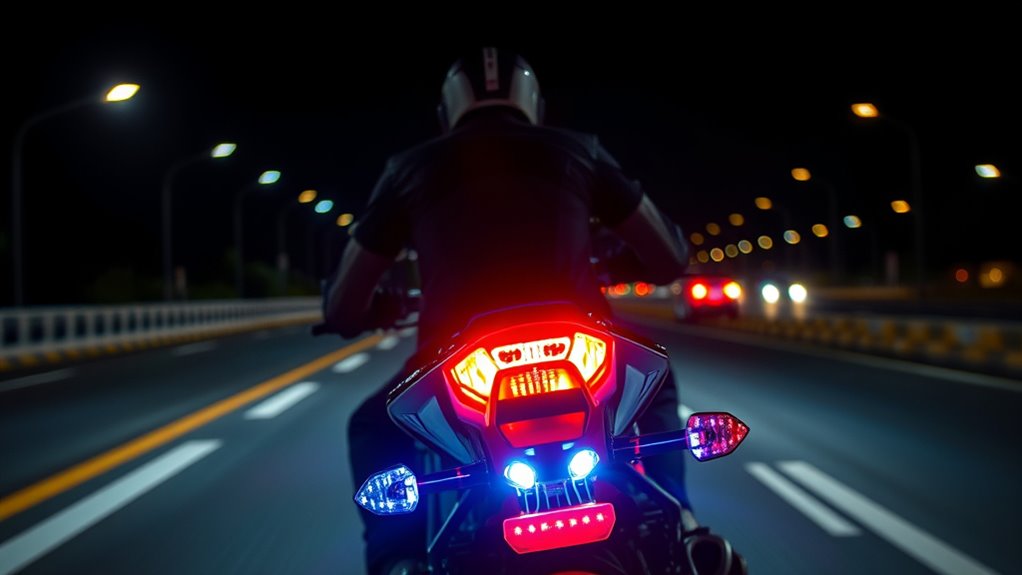
Incorporating flashing lights and signals into your night riding setup substantially enhances your visibility and safety on the road. Flashing lights draw attention, alerting drivers to your presence and reducing the risk of accidents. Proper signals communicate your intentions clearly, helping others anticipate your movements. To maximize effectiveness, consider using synchronized lights that alert from multiple angles. You can also select high-visibility colors, such as red or amber, for better recognition. Additionally, guarantee your signals are consistent and easy to activate, so you can respond quickly in dynamic situations. Remember, well-placed flashing lights and signals serve as vital safety tools, making your night rides more secure and confident. Enhancing your visibility is essential for safe night riding. Nutritional advantages of green juice can also be considered when planning your energy and hydration strategies for long rides.
Best Practices for Riding in Low-Light Conditions
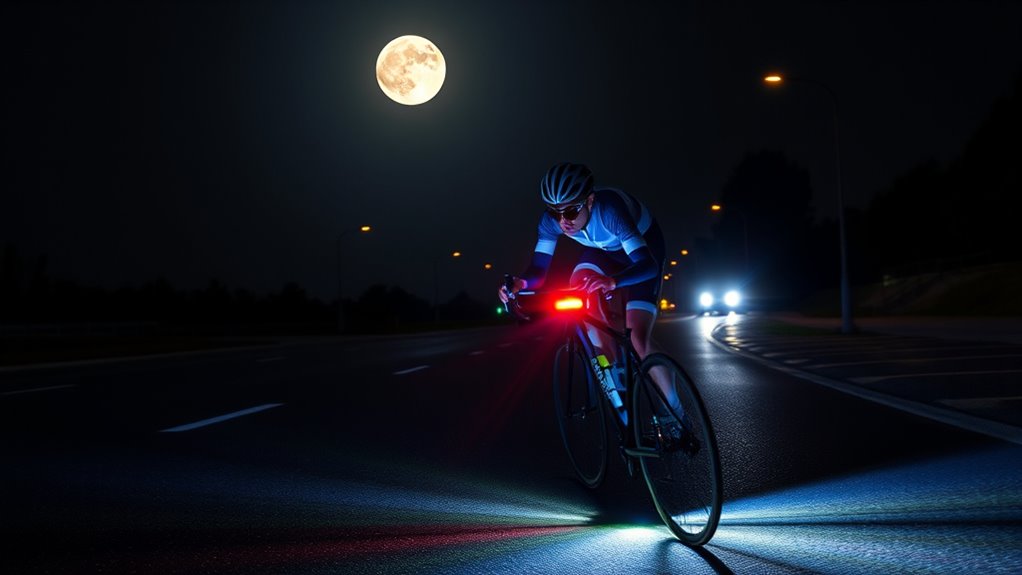
Riding in low-light conditions demands extra vigilance and preparation to stay safe. Always make sure your lights are functioning properly before heading out, including your headlights, taillights, and any auxiliary lights. Reduce your speed to give yourself more reaction time and avoid sudden movements. Stay alert to your surroundings, scanning ahead and to the sides for potential hazards like animals or debris. Use reflective gear and clothing to increase visibility, especially at intersections or in areas with poor lighting. Keep a safe following distance to give yourself ample space to stop if needed. Signal your intentions clearly with hand signals or lights, and avoid distractions like mobile devices. Following these best practices helps you navigate low-light terrain confidently and reduces the risk of accidents.
Regular Maintenance and Inspection of Lighting Systems
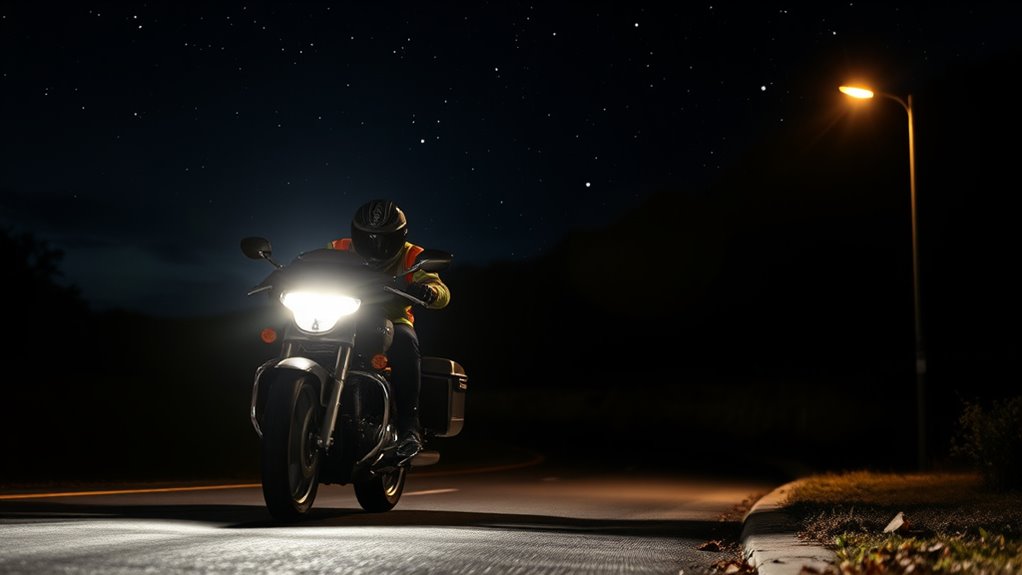
To guarantee your lighting systems stay reliable, you need to check their functionality regularly. When you notice worn-out components, replace them promptly to avoid dim or faulty lights. Keep your lights clean and properly adjusted so they shine brightly and accurately, enhancing your safety on the road.
Check Light Functionality Regularly
Regularly checking your bike’s lights guarantees they work properly when you need them most. You should inspect both front and rear lights before every ride to ensure they’re functioning correctly. Look for any flickering, dimness, or loose connections that could impair visibility. Testing your lights in a dark environment helps verify they illuminate sufficiently.
Remember to:
- Confirm all bulbs are intact and not damaged
- Ensure batteries or power sources are fully charged
- Check that switches and wiring are secure and free of corrosion
Regular inspections prevent unexpected failures during night rides and enhance your safety. Taking a few moments to verify your lighting system keeps you visible and reduces the risk of accidents caused by faulty lights.
Replace Worn-Out Components Promptly
Ensuring your lights stay effective requires more than just checking them before each ride; it means replacing worn-out components promptly. Over time, bulbs, batteries, and wiring degrade, reducing brightness and safety. Regular inspection helps you spot issues early. Keep spare bulbs, batteries, and connectors on hand to avoid delays. When a light dims or flickers, replace the part immediately to maintain visibility. Here’s a quick visual:
| Component | Signs of Wear | Replacement Timing |
|---|---|---|
| Bulb | Dim, flickering | As soon as it dims |
| Battery | Shorter run time | When performance drops |
| Wiring | Frayed or loose | During routine checks |
| Connectors | Corrosion or damage | At the first sign of trouble |
Prompt replacements ensure your lighting system remains reliable night after night.
Clean and Adjust Lights
Maintaining your bike’s lighting system involves more than just replacing worn-out parts; it also requires regular cleaning and adjustments to keep everything functioning at its best. Dirt, dust, and moisture can diminish light output and cause uneven beams. To guarantee optimal visibility, inspect your lights frequently, wiping lenses with a soft cloth and checking for any cracks or fogging. Adjust the beam angle so the light properly illuminates the road without blinding others. Proper alignment improves safety and efficiency.
- Check for corrosion or loose connections in wiring
- Clean lenses and reflectors for maximum brightness
- Verify that all mounts are secure and properly aligned
Frequently Asked Questions
How Do Different Weather Conditions Affect Night Riding Visibility?
Different weather conditions considerably impact your night riding visibility. Rain, fog, or snow can reduce your ability to see clearly and make it harder for others to spot you. Wet roads can cause glare, while fog and heavy rain decrease distance perception. You need to slow down, use proper lighting, and stay alert in adverse weather to stay safe. Adjusting your speed and lighting helps you stay visible and react promptly to hazards.
What Are the Legal Requirements for Bicycle Lighting at Night?
You need to follow your local laws regarding bicycle lighting at night. Typically, you’re required to have a white front light and a red rear reflector or light to stay visible and safe. Some places specify brightness levels or additional reflectors on pedals and wheels. Always check your area’s regulations before riding at night to make sure you’re compliant and avoid fines or safety issues. Proper lighting helps you see and be seen.
Can Reflective Gear Replace Functional Lights During Night Riding?
Did you know that reflective gear alone can increase your visibility by up to 80%? Reflective gear is helpful, but it shouldn’t substitute functional lights during night riding. Laws typically require front and rear lights for safety and legality. Functional lights ensure you’re seen clearly by drivers, especially in low-light conditions. Relying solely on reflectors puts you at risk, so always equip your bike with proper lighting for safe night riding.
How Does Rider Speed Influence the Effectiveness of Lighting Solutions?
Your riding speed directly impacts how well your lighting solutions keep you safe. When you go faster, your lights need to be brighter and more focused so you can see obstacles ahead clearly. At slower speeds, reflective gear might suffice, but at higher speeds, functional lights are essential to detect hazards early. Adjust your lighting setup based on your speed to stay visible and avoid accidents effectively.
What Are the Latest Innovations in Night Riding Safety Technology?
You’ll find that the latest innovations in night riding safety technology include smart lighting systems that adapt to your speed and environment, increasing visibility. Wearable devices now feature real-time alerts for nearby vehicles and obstacle detection. Additionally, advanced reflective gear and integrated GPS tracking enhance safety. These innovations work together to improve your awareness, helping you ride confidently and securely even in low-light conditions, making night riding safer and more enjoyable.
Conclusion
By lighting up your ride, you become a beacon in the night’s dark embrace, guiding your way safely through shadows. With the right headlights, reflective gear, and flashing signals, you turn every night ride into a luminous adventure. Keep your lights shining bright and your speed in check, like a steady heartbeat in the quiet night. When you prioritize visibility, you’re not just riding—you’re illuminating a safer path for yourself and others.
